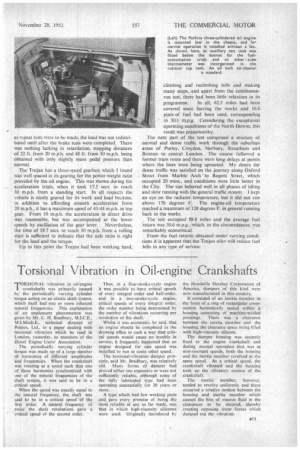Torsional Vibration in Oil-engine Crankshafts
Page 45

If you've noticed an error in this article please click here to report it so we can fix it.
'TORSI ON A L vibration in oil-engine crankshafts was primarily caused by the periodically varying cylinder torque acting on an elastic shaft system, which itself had one or more inherent natural frequencies. This explanation of an unpleasant phenomenon was given by Mr. C. H. Bradbury,
M.F.Mech.E., technical director of Petters, Ltd., in a paper dealing with torsional vibration which he read in London, yesterday, to members of the Diesel Engine Users' Association.
The periodically varying cylinder torque was made up of a large number of harmonies of different amplitudes and frequencies. When the crankshaft was rotating at a speed such that one of these harmonies synchronized with one of the natural frequencies of the shaft system, it was said to be in a critical speed.
When the speed was exactly equal to the natural frequency, the shaft was said to be in a critical speed of the first order. A natural frequency of twice the shaft revolutions gave a critical speed of the second order. Thus, in a tour-stroke-cycle engine it was possible to have critical speeds Of every integral order and half-order, and in a two-stroke-cycle engine, critical speeds of every integral order, the order number being determined by the number of vibrations occurring per revolution of the shaft.
Whilst it was axiomatic, he said, that an engine should be completed in the drawing office in such a way that critical speeds would cause no trouble in service, it frequently happened that an engine designed for one speed was installed to run at some other speed.
The torsional-vibration damper principle, said Mr. Bradbury, was relatively old. Many forms of damper had proved either too expensive or were not sufficiently reliable, although some of the fully lubricated type had been operating successfully for 20 years or more.
A type which had few working parts and gave every promise of being the most reliable of any so far made, was that in which high-viscosity silicones were used. Originally introduced by
the Houtiaille Hershey Corporation of America, dampers of this kind were now manufactured in this country.
It consisted of an inertia member in the form of a ring of rectangular crosssection hermetically sealed within a housing consisting or machine-welded pressings. There was a clearance between the inertia member and the housing, the clearance space being filled with high-viscosity silicone.
The damper housing was securely fixed to the engine crankshaft and during normal operation that was at non-resonant speeds, both the housing and the inertia member revolved at the same speed. At a critical speed, the crankshaft vibrated and the housing took tip the vibratory motion of the crankshaft:
The inertia member, however, tended to revolve uniformly and there occurred a relative motion between the housing and inertia member which caused the film of viscous fluid in the clearances to be sheared, thereby creating opposing shear forces which damped out the vibration.




















































































